Wooden house-building B. last years It began to develop rapidly. For construction, it was mostly acquired by eco-friendly wood, a bar or a log. The first option is not all can afford due to the high value of the material, and chopped logs are an excellent and inexpensive way of erection of a warm and natural home.
Log cabin during construction must necessarily be insulated with interventic insulation. After all, the logs have not perfectly smooth sizes and proportions, and put them on each other without the presence of gaps between them it is impossible. Insulation in the markets exist in a large range. Not an experienced builder is not easy to make the right choice.
Heat tarters for cutting hand logging
Wooden houses are built mainly of hand logging logs. These materials are not expensive and affordable, possessable to the same good characteristics. For their insulation, both artificial and natural interventional materials can be used.
- Synthetic heaters are made of artificial materials. They are mineral, balsovate fiber heaters, polystyrene foam, etc.
- Natural interventic insulation manufacturers are manufactured from natural materials, plant fibers. The most popular are Jute, Moss, Pakle, etc.
The best interventic insulation, according to experts
Synthetic and natural materials can cope with the task of insulation of the house. They have good thermal insulation characteristics. But do not forget why many are building wooden houses. The main criterion for choosing this building material is its naturalness. So why spoil the whole environmentally friendly picture of the house using synthetic materials that can cause allergies at the tenants.
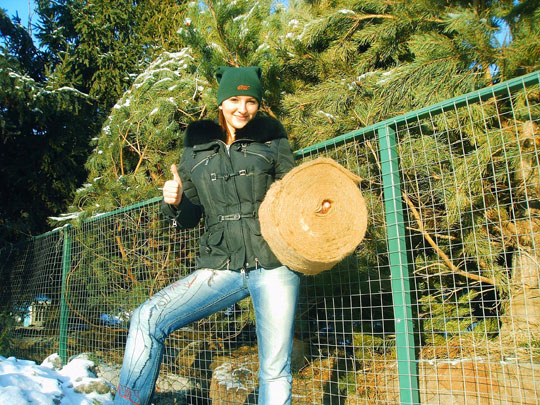
Synthetic insulation can be compared with a polyethylene film, they do not let the air and prevent the breathing of wood. It turns out in interventic seams a greenhouse effect, which leads to the formation of mold, fungi and rotting of a wooden material. Therefore, you should not use them, even despite their good thermal insulation characteristics. After all, insulation should not make harm to the main construction material.

Another thing is natural interventical insulation that they can say that they complement the characteristics of teak logs being between their crowns. These materials have good thermal insulation, hygroscopicity, vaporizolation. They do not interfere to breathe wood, do not interfere with the exchange of air indoors. Many natural heaters have unique bactericidal properties, protecting the house from bacteria. Also in their composition has a component of Lignin, which prevents the formation of biological agents in the interventorystone.

For the insulation of their chopped home, it is desirable to choose the insulation from the following main materials:
- Moss. This material is the most popular and verified. It was used as an interventory insulation a few hundred years ago, and so far you can meet some wooden house in good condition. Moss is inexpensive material and affordable, because it grows almost in any region of the country. But for insulation it is not suitable for any kind of moss, you need to use only sphagnum and cucushkin flashes. They have excellent hygroscopicity, absorb a large amount of moisture, provide houses good ventilation and optimal air humidity level. But this material also has one disadvantage, this is the absence of fire resistance. Also, it is not easy to lay it, you need to have the skills of working with him.
- Jute tape. This insulation in its properties is very similar to moss. But it is much easier to work with it, thanks to its form in the form of a tape. It is folded on the log and is firmly fixed by a construction stapler. The laid jute insulation will not be able to pull the bird from the interventory space. Its beautiful golden shade looks good with a tree.
- Tow. They are made from various natural materialsmaybe jute, linen or mixed. Its quality can be high and low, it all depends on the material used. The best believer is the package that the percentage of the content of Jute is high. By appearance Pacle reminds Wat, she is the same fluffy. It is recommended to use it only for cutting cut. It is easy to break up the parts that are not necessary in size due to its material structure, which cannot be said about the belt jute insulation.
Video from expert:
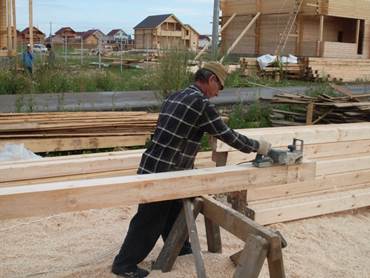
A little more than a year ago with her family acquired the city of Earth and began to build small dacha. Selection among all building materials fell on the tree, namely on the chopped inexpensive logs. I wanted to have a warm, beautiful and eco-friendly home, the more we planned periodically to live there (during the holidays of children, weekends and vacations). For the same reason, we accommodatedly approached the insulation of the house. The selection of insulation was not just not just, the interventic materials are available on the market a very large amount. It is good that we caught a consultant who is a professional in the construction sector. He suggested buying a insulation from jute in the form of a tape, and we agreed.
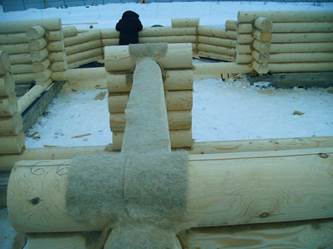
Laying the ribbon between the logs was very easy and fast. Our interventic seams were neat. In winter, there was warmth in the house, drafts were not observed. A year later, our house gave a shrinkage, in some places (mainly in the corner) there were insignificant gaps, which I was insulated with jut pacles the other day. For the initial warming of the log house better materialthan the jute tape is not found. I don't even imagine how I would put Moss, because I don't know how to work with him. I can say for sure, as a result of construction, the thermal insulation of the house would be definitely violated despite even the excellent characteristics of the MCH.
Nikita Maslov, 35 years old (Nefteyugansk).
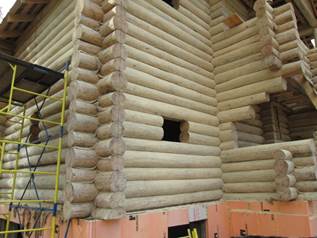
All natural insulation are good choice For insulation, cutting a hand loggy. They are able to insulate the house, adjust its microclimate and humidity level. Jute tape is better to use non-professional builders who do not have experience with the insulation. Moss can be applied to those who have come across him, and knows the specifics of his work. And the packle is great for the cacopa, which is carried out after the final shrinkage of the house. Also, the final choice may also affect the financial side, not everyone can allow to insulate their home by expensive insulation materials. But even in this case, it is not necessary to acquire synthetic materials, they are not able to replace natural insulation and bring only harm to the wooden house and large financial costs.
Where to buy a good, high-quality interventic insulation for a log house?
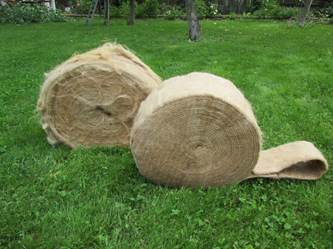
Our retail and wholesale store.
You can see the current prices.
Content:Jute is considered one of the best interventic insulation. It is environmentally friendly, not crushed, does not absorb moisture and tightly closes the space between the bar. But modern jute produce various species, which one is better and what they differ in told in this article. We learn how much the jute inter-night insulation in large cities, such as Ufa, Kazan, Moscow, St. Petersburg.
Why do jute better than other insulation?
Made a jute insulation from the fibers of the tropical tree of the same name. The reasons why this tree is used is two:
- Objective. Jute tree in its texture is akin to flares and henekening, and they were used for insulation wooden houses More our grandfathers. In its chemical and physical indicators, they are close.
- Subjective. The traditional hemp is received from hemp to get in Russia difficult, for a number of reasons. It is difficult to grow and preserve flax, so flax goods in Russia have almost ceased to exist. For this reason, in Russia there was a shortage of raw materials. For the manufacture of linen insulation. Therefore, the jute fiber has become in demand in the Russian market, despite its foreign origin.
Pros and Cons Jute Material
For insulation wooden house From the bar, the jute inter-night insulation has a number of advantages that are only peculiar to this material:
- Golden painting which is close in a color of a bruster of pine or ate.
- Of all the insulation, only the jute contains the largest number of lignin. Lignin is a resin, which not only protects the insulation from rotting, but also glues a bar making interventional space hermetic.
- It is more hard, therefore it is practically not crushed over time and retains heat in the house equally, both immediately after construction and after 10-15 years.
- High density gives the material with high heat-saving properties.
By the cons of the jute insulation, its rigidity can be attributed, the ribbon is harder to lay as out of flax or hemp. It is more difficult for them to make an additional caulkit, so it is better to lay the jute tape of a smaller width, and to perform a pantry with a cord. And if you select the density of the jute insulation correctly under each breed of wood, the rigidity will not be scary.
Myths - True or fiction?
 Myths that are increasingly possible to read in the network about jute insulation are not all true. Consider some more:
Myths that are increasingly possible to read in the network about jute insulation are not all true. Consider some more:
- The jute interventical insulation gives a uniform warming and shrinkage of a wooden house, providing protection better than flax or hemp. This applies only to high quality jute insulation, but often in our stores there is a very poor quality material. And the mixed species are made not with the addition of flax fiber, as stated and with dust from the rope, vessels. Heat wooden house Such material and wait for good indicators from it.
- Jute has the highest ecology. This is true, but not the most, since both flax and hemp are made of natural raw materials. And if you purchase a poor-quality jute, then it contains many different chemical additives.
- Jute do not love birds and do not take it into their nests. It is not true to birds anyway, what kind of natural or non-carrying material to drag into the nest. Therefore, the jute pluck out the walls in the same way. It is necessary to acquire the material from short fibers not more than 3 cm, then the birds will not be interested.
- Jute insulation has a shelf life of 75 years. Indeed, Danish scientists conducted research at the Finnish "Eurolne", which has nothing to do with the Russian jute insulation. Therefore, to say exactly how much service life at Jute is accurately difficult, it may be even more.
What interventical material is produced on jute fiber
![]() Jute insulation is currently producing three various species. Just every company can call them in its own way and add the composition of various components.
Jute insulation is currently producing three various species. Just every company can call them in its own way and add the composition of various components.
- Pakle jute in the form of a tape.
- Felt from jute.
- Combined jute with various impurities.
Jute Packs are produced from 100% jute fiber. It is soaked, scratch and passing through special machines produced in the form of a ribbon. The material has a smaller density, but there are no extraneous impurities in it. Moreover, processing the jute fiber in a similar way fibers do not burst, as in the production of felt. It is convenient for them to care houses or baths from the bar, as it is practically like flax in the softness of the panel. The main characteristics of the jute paneling in the tape: width 15 and 25 cm, length 80-150 m, density 80g / m or 550 g / m. (Thermal).
Jute felt reminds usual out of wool, but tougher and dense. Reviews of it are mostly positive. It is manufactured by dumping wet small fibers Jute. It has high density and hard enough. It is good precisely to use between the crowns. It is difficult for me to pant. Various manufacturers of cunning and use in the manufacture of jute felt only 90% of jute, the rest of the various additives (flax, the fiber from flax processed into small fibers, etc.) minus felt in his sweeping, as it is hard enough. This leads to the increment of the insulation, but softens its texture.
Mixed option when the jute add flax or other components. This species was specifically designed for several reasons:
- Reduce the cost of production.
- Help the buyer who cannot determine what is better than flax or jute.
A mixed insulation has a pleasant texture and at the same time strong enough, since soft flax fills the spaces between the rigid fibers of the jute (Lenjut).
In a separate group, a jute insulation combined with synthetic fibers can be attributed. He keeps the form well, but at the same time loses its environmental friendliness. And the worst thing is that such material sellers are not rarely issued for natural jute, from here bad customer reviews.
FEATURES OF MONTAGE
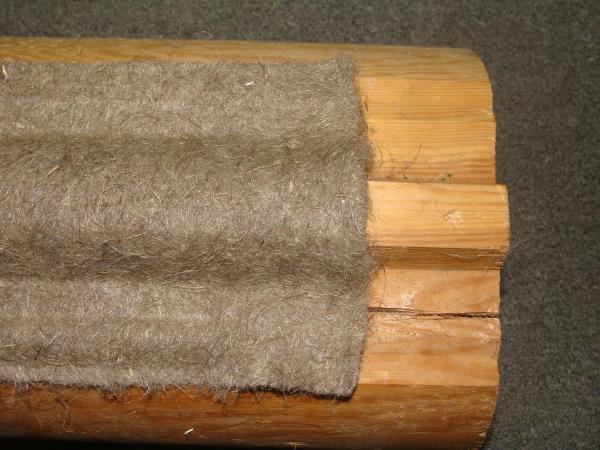 Any of belt insulation can be bought by the necessary width, so it is not difficult to choose a different log size or timber.
Any of belt insulation can be bought by the necessary width, so it is not difficult to choose a different log size or timber.
To fully fulfill all the stated requirements, you must select the correct density parameters and the width of the insulation. And you need to pay attention not to the thickness, but on density. Only so you can determine the material load from the walls of the house or bath.
For permanent residence in the house, it suffices to take a thickness of 5-6 mm, with a density of at least 400-600 g / m. If a bot is a good quality, it is enough to lay a tape into one layer. In case of questionable quality, wood can be found in a 2-layer.
When choosing, take a jute consisting of a fiber more than 2-3 cm, then the hard insulation will be sprinkled and the uniformity of the material will be unequal. And all its qualitative characteristics will be lost.
It rolls uniformly throughout the surface of the log and attached the stapler in 50-100 cm increments
.
The price of material in major cities
The price for the jute interventic insulation in large cities, such as: Ufa, Kazan, Moscow, Nizhny Novgorod and St. Petersburg, Novosibirsk differs little. It is a mixed type of cheaper than natural. Felt due to the specifics of the manufacture is more expensive than pacles, but has a greater density. It is good to use it for the insulation of a bath of a bar ,.
You can buy material on the construction market, in specialized stores, or the Internet. And the price on the Internet may be at times lower. The cheapest option to buy directly from the manufacturer, the minimum wholesale party from 50,000 rubles. For the construction of a big house, this is enough, will remain on the bath.
The average price for insulation from jute in major cities:
The most expensive material in the city of Novosibirsk. Just in Moscow and St. Petersburg a lot of wholesale vendors, and in Novosibirsk and Ufa, they are mainly working overbugs that acquire the material in larger cities and resell. It is more profitable to buy material via online stores, the price will be below 10-20%.
No matter what insulation from Jute you did not have chosen to insulate your home or bath, the main thing is its quality. If the manufacture of unauthorized ventricular components, Jute loses a number of their qualitative characteristics. The correctly selected material will serve not to one generation and will reliably protect the walls from the cold.
Frequently, a bath from a log was insulated exclusively with a pantry - when natural material was pushed between the logs manually. And this method has, of course, its undoubted advantages. But the disadvantages are not happy: not enough that all work on the pantry is quite laborious, it requires special skills and goes far from one stage, so also the caperpath itself for many bunchings to pull the birds. From what experienced builders It is recommended to see such a bath of expensive siding to see such a bath - but why did she even build it from an environmentally friendly beautiful log? But, fortunately, today there are other types of interventional insulation - no less eco-friendly, even more practical and completely excluding. And what modern interventic insulation is better to help decide this article.
Interwidden insulation: how to choose? What is the better interventor insulation for a bath? It is impossible to answer these questions unambiguously - each has its own pros and cons, and some advantages.
Membling Head Wool Insulation
A good interventic insulation for a profiled timber - from sheep wool. For insulation wooden bath He is just perfect - the truth is not enough. But absolutely does not fit and in terms of its qualities, it is significantly superior to all modern belt insulation.
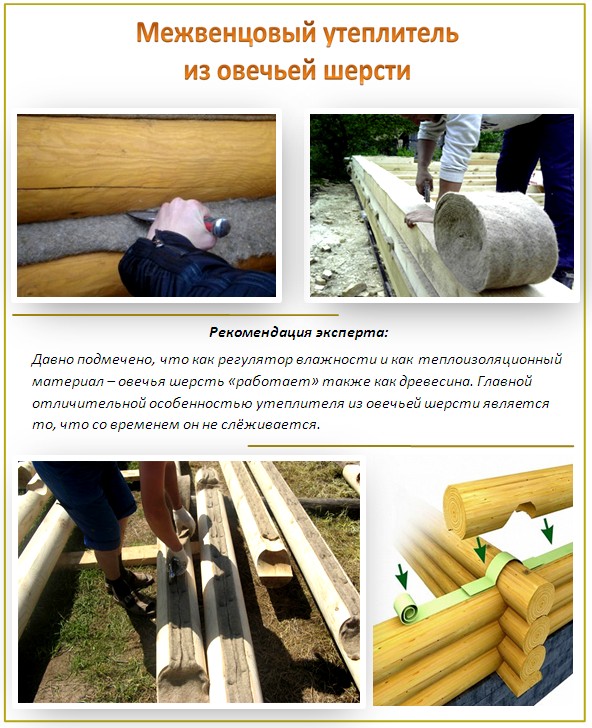
Tape interventian insulation
This insulation is quite new for russian marketHowever, it has already managed to conquer its popularity. His main advantages are that in general, the whole building assembly occurs quickly, labor costs are reduced, and the insulation itself does not accumulate moisture, is not blown, hypoallergenically and completely not attractive for birds. High-quality belt insulation gluits after laying walls.
It is interesting for its composition: natural fibers break through special needles with hooks-jar, and, intertwining among themselves, these fibers form a sufficiently dense substance, which in its structure resembles felt. His standard dimensions Such: Length - 10-50 Ramating meter, width - 100/125/150/200 mm, and thickness varies from 5 to 15 mm. Different with this insulation and surface density - 300-800 g \\ sq. M.
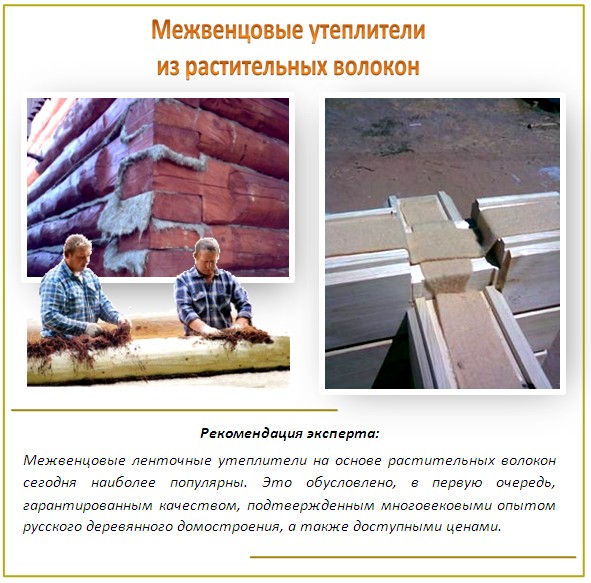
But the most important thing is to determine the thickness of the tape insulation, because It must be selected depending on the cut thickness. So, for chopped wood, a heater is needed 15 mm thick, for a conventional timber - 8-10 mm, and for glued - 5 mm.
There are also its features of such a insulation. So, if the bar is uneven, put better tape in two layers.
The same belt insulation today is made from flax or jute, or in the combined version - the flanutin, the percentage of the ratio of materials in which may be different are. What their quality and scope depend on.
A popular jute interventic insulation today is considered an excellent alternative to expensive pant. It represents a ribbon with a thickness of 5/10/15 mm, a sufficiently dense and homogeneous. It is necessary to roll it right in the groove, fixing in the course of a construction stapler. And after laying a cut, Jute condenses even stronger - its fibers glue and acquire enviable resistance to wind and moisture.
Walls with this insulation are beautiful, with perfect seams, warm and not needing in any other finish. And the jute fiber, in contrast to flax, uniform thickness and easily spread over the crowns.
Interwidden linen insulation
Although this stake has its advantages. For example, he quickly absorbs and quickly gives moisture, and the walls really "breathe". Flax is not allergic and not dangerous to health, does not create a static charge and well prevents the appearance of fungus on the walls. In addition, if the interventic insulation for a bar is precisely from flax, no other ventilation the bath is not necessary. And the most important thing is that such a heater does not have intersection, and therefore harnesses can be made by hands of any length and shape.
And finally, more environmentally friendly material for the insulation of the walls do not invent - even linen clothing is considered healing.
Combined Heattels: Mezernantic Heater Linovatin
As for the combined options, the larger in the tape insulation of the jute, the way it is less powerful. Indeed, this plant contains a special polymer of lignin, which fastenses in the wood the very fibers of cellulose. But in the Lena of this substance is only 2%, and therefore it is more susceptible to moisture. In addition, the more flax in the insulation, the more likely that it will eat it, but the jute pest does not like. And jute is blowing much less flax.
How to find out that in the interventory insulation there are no additions of flax? Easy - in color. It must be golden, i.e. Light brown, but gray splasions say that Lena was added to it.

Meztz jute insulation
Currently, materials from both synthetic and artificial fibers are used as an interventional insulation of wood structures. The most common natural belongs are ribbon jute (different mixtures), flank (ribbon flax), flabbling, palable and moss.
It is especially valued by modern builders The technological capacity of tape insulation, the use of which significantly accelerates the assembly and contributes to uniform filling across the entire width of the interventory space. Conduct a comparison of various belt materials, for which we consider the "thin" and "lush" jute insulation.
Questions and Answers about the interventor insulation
"Magnificent" Jute Interwette insulation appeared on the market recently. This material Attracts attention at the expense of its "thickness" and a low cost. But here it is necessary to take into account that the external "pomp" hides the significantly lower surface density material.
What follows from this? The mass of the house is evidently "pomp" in a matter of times. In fact, the weight of the insulation (his real thickness) is important.
How is the cheapest and magnificent jute make? The jute fiber connection is carried out by a chemical gluing method (the so-called thermosklack) - the combination of the fibers between itself occurs under the influence of high temperature using synthetic materials (usually Lavsana).
![]()
Jute's gasket in a rounded log cabin
With the method under consideration, there is a decrease in the consumption of raw materials at times, which leads to a lower cost compared to other analogs, which are manufactured using the needle-free technology (fiber mounting is carried out by long jute fibers that are tangling short). This, of course, is not good for the high-quality indicators of "lush" and cheap products.
Decent producers use the needle technology, which significantly increases the quality and homogeneity throughout the surface of the heat-insulating material for the warming of a church. (Let a little and more expensive). This event leads to the fact that the insulation does not get lazy, "breathes" (does not accumulate moisture), does not produce harmful chemicals that destroy the log house. In addition, such material is very easily drilled when the hardening equipment under the impudent.
What should be considered to not make the purchase of air? The density of the surface of the interventovation insulation is depending on the following indicators: the width of the roll, weight and length on the roll of the ribbon insulation. The length and width are already known when buying, the weight is easy to determine when weighing. Then all known data are substituted in the calculation formula:
The surface density is directly proportional to the weight (gr) and inversely proportional to the width (m) and length (M). The obtained value is compared with the one indicated by the manufacturer (seller): 5 mm thickness is about 400 g / m2; Thickness from 8 to 10 mm - about 600 g / m2; Thickness 15 mm - about 800 g / m2. In no case should not save, since the interventional compound is the most "weak" part of the wooden structure.
What does the color of the insulation indicate? It depends on the presence in the jute insulation of additives of other materials and from the variety of the source jute used in the production process. Everything else is just myths.
Is the use of a comprehensive jute insulation (flax + jute)? Adding flax to the jute tape in any quantity will reduce the quality of interventovation, but will contribute to the cheaper production. A key role is assigned to the following factors. Mole. It is a "good" creation (or rather, the grain and furniture) tear off the insulation of flax, often does not even eat it.
The cost of interventory insulation is, as a rule, up to 2% of the total cost of the house, but the wrong choice of such a material may cause significant troubles and additional costs. Therefore, it should be saved with the mind.
Technology laying
The insulation is placed in the wints mostly three ways, depending on the thickness of the layer:
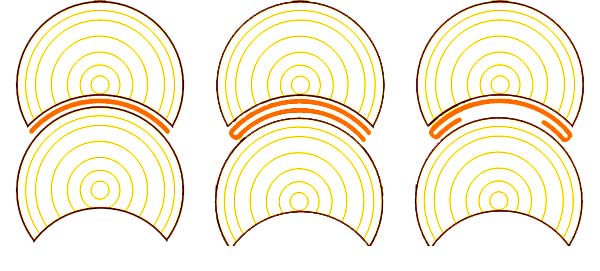
- Single layer Jute
- Folding on the facies insulation
- Folding the edges of the interventore insulation
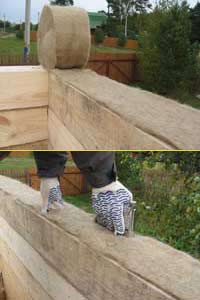
Installation on the bar
Rounded log
House of profiled / glued / black bar.
The insulation from the jute buy an equal width of + - 2 cm) with a thickness of 5-8mm.
For a chopped log, you use a wider jute felt with a thickness of 10-15 mm, the excess width is usually prevented and permanent.
"Interwidden insulation is a gasket material between the wedges of a wooden house (Bani) made from a bar or logs."
Good day to everyone who decided to look at my blog!
Since a long time, wooden buildings were insulated with a pantry. That is, natural material pushed between the brothers (more about it in more detail). It is worth mentioning that the current insulation materials went far ahead, in terms of practicality. Therefore, today we will try to find out what to choose an interventic insulation for a bar and logs? Consider different types. And natural, and partially natural, and synthetic. Go!
Of course, a tree as a material has a lot of advantages. However, insulating the crowns, it is necessary. If the insulation is laid or selected incorrectly, it will not become one with a tree and valuable properties Woods will manifest badly.
Main requirements for insulation
- Uniform density and good elasticity. It must well close the seams between the bar not only during construction, but also after the shrinkage of the building;
- Must have a low thermal conductivity;
- The ability to absorb and give moisture is like a tree (this allows you to maintain the necessary moisture content of wood and protect the house or bath from dampness);
- Resistance to temperature differences and solar radiation action;
- "Reziness" in relation to insects and birds (the "harvest" for nests);
- Durability and preservation of its operational qualities;
- Absence harmful substances for our health;
- Antiseptic properties that prevent the biological damage to fungus and mold.
"Wrong insulation"
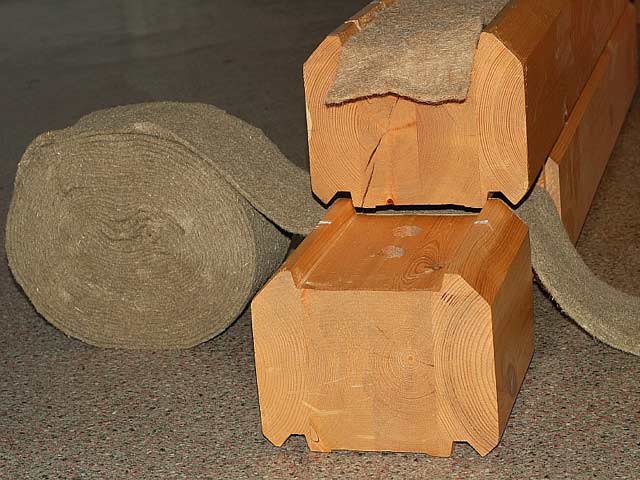 Materials with a closed pore structure (Penoplex, etc.), synthetic sealants (silicone, acrylic, etc.), sprayed and foamed polyurethane foams - it is impossible! Why? Because they are playproof.
Materials with a closed pore structure (Penoplex, etc.), synthetic sealants (silicone, acrylic, etc.), sprayed and foamed polyurethane foams - it is impossible! Why? Because they are playproof.
A wet steam comes from the building, at the point of dew will begin to turn into condensate. And the fraught condensate inside the thermal insulator, more than once it was said, for example,.
Types of interventic insulation
To begin with, we divide all the material into two types: natural and artificial.
It should be noted that x / b and wool for interventional insulation of the house or bath is not enough. They have one common drawback. Guess? Well absorbed and do badly give moisture. And they "respect" insects and birds.
What you need to know about the density of the insulation? By the way, each self-respecting manufacturer, indicates this parameter. And he should be:
- For houses from glued timber:ranging from 300 to 400 g / m. square, with a thickness of 4-6 mm.
- For a pinned log: - from 450 to 550 g / m. square, with a thickness of 8-12 mm;
- For profiled timber:- from 250 to 350 g / m. square, with a thickness of 2-3 mm;
If the wood has an uneven surface, the seal must be thicker.
So, what kind of natural options are most suitable in the construction of wooden houses or baths? It is a pack of flax, jute or hemp; Long fuel moss and not a woven felt. Now about these components in more detail:
Let's start with forest moss
"Not every moss is suitable. Typically use such types: red, sphagnum and cukushkin Lyon. "
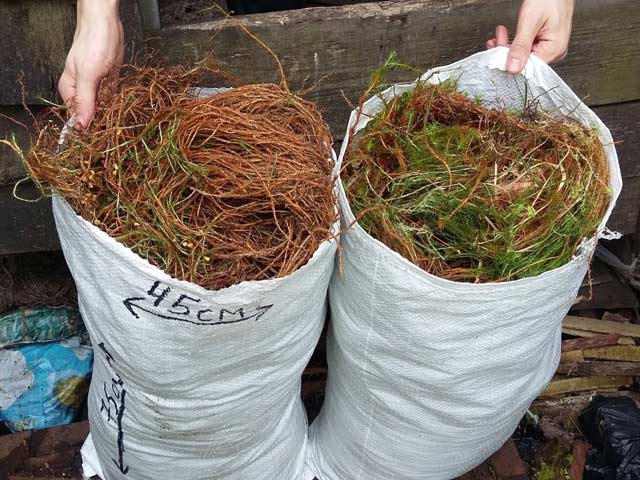 Kukushkin Lon.
Kukushkin Lon. 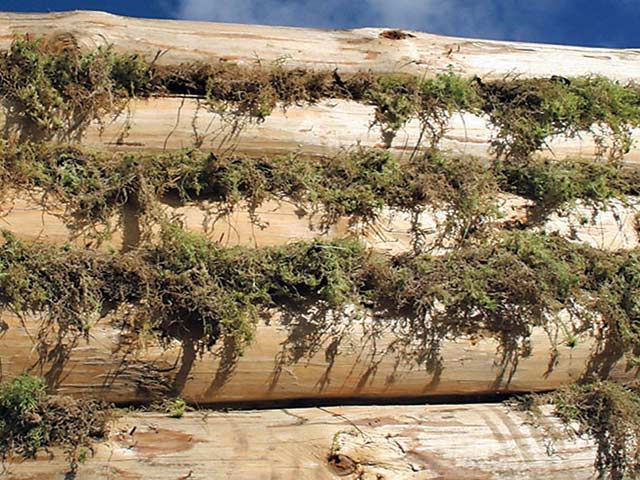 Build a bath
Build a bath
Looking moss, it is necessary to leave a fringe (as in the photo), which is subsequently stuffed into the slot with a special tool with an experienced specialist, that is, you. A year later (after the log house gives a shrinkage), moss must be treated: where you need to sink, and where and somewhere ...
Tow
"This material is waste from the initial processing of certain types of plants. It includes cellulose, lignin, pectin and a little wax. "
Modern natural materials
Jute bars
Perhaps one of the best in the ratio of "price-quality".
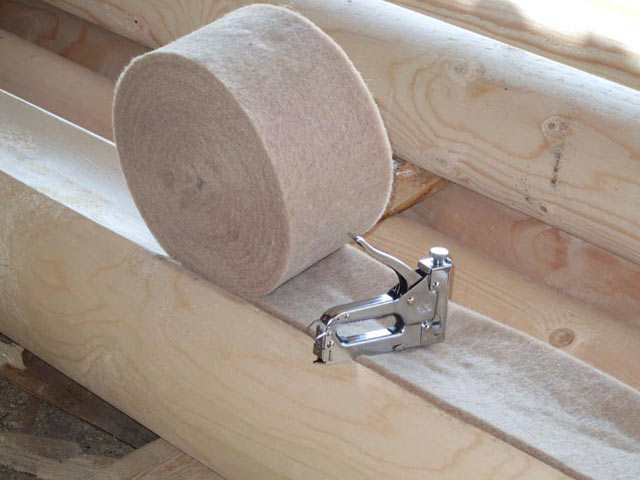
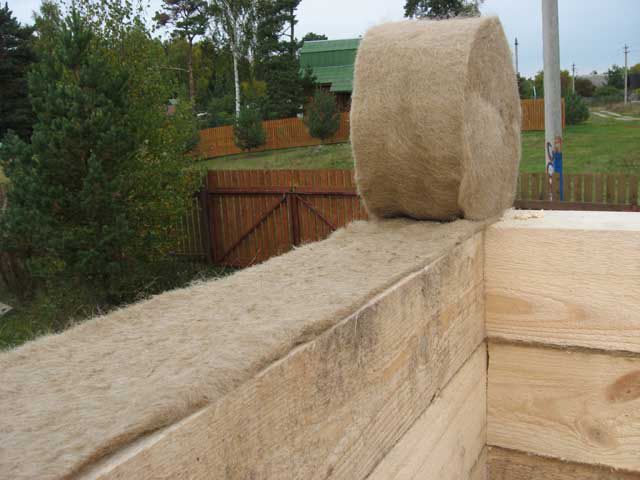
Available in several sizes. The width varies from 2 to 100 cm, thickness from 4 to 12 mm, the density is ≈ 700 g / m². You can comfortably and quickly roll right into the groove, in the course fixing the stapler. After laying, the jute canvas compacted and becomes resistant to moisture and wind. Great for timber. Seam looks symmetrically, and its golden shade is pleasantly harmony with the color of wood.
"The jute canvas is practical for the bath, because his fibers are well removed by moisture."
Linnatin
Depending on the manufacturing technology, it may be called differently. Refers to a stigled canvase (made by a needle-crying method).
Caution!Buying this product, pay attention to the structure. Will not notice very short fibers, trimming threads, twine and splashing other colors, know - in the material there are recycling products. For example, utilized mischromatic, rags, etc. It is not quite good. Such a heater will be fragile. And besides, it is unknown, under what conditions processed products were operated.
Synthetic interventic insulation
Hollofiber
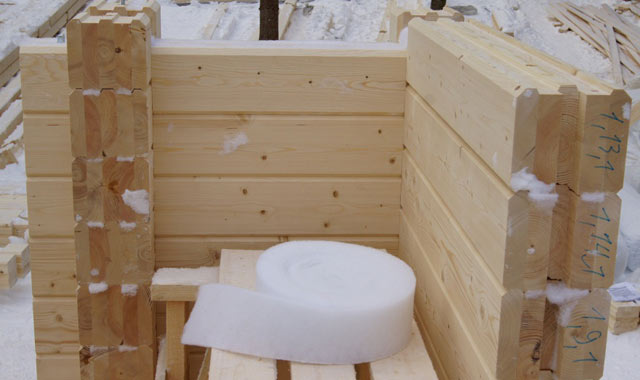 Non-woven material based on polyester fibers. Basic application: as a heater for outerwear and bedding. The kind of synthet known to us.
Non-woven material based on polyester fibers. Basic application: as a heater for outerwear and bedding. The kind of synthet known to us.
It is produced in two types: the canvases (rolls) and the formation (hardhas) having different rigidity and density. The choice in each case is due to wood features.
Especially valuable quality - elasticity (recovery of volume). For example, there are no grooves in an unpainted bar, and during seasonal drying it twists it. When the traditional seal is used, there are gaps that need to be caught in such situations. In addition, natural heaters are pressed and dried under the pressure of the bar. Hollofiber due to elastic regeneration ensures efficient filling of cavities.
The material is now produced in Russia, at the "Thermopol" plant in Moscow.
Polterm.
In a sense, this is a kind of holofiber.
Polterm is sold in the form of a tape: width: from 30 to 250 mm; has a thickness of 8 - 20 mm; restored after compression by 90%; Color is golden-beige. All parameters and characteristics are similar to holofiber, so we will not list.
For a few simplified understanding, I will give a comparative table. Many parameters of the usual jute and polytermone interventional tape are compared here.
| Name | Jute (ribbon) | Polyterm (tape) |
| Do you need a re-cachat after shrinkage at home? | yes | not |
| Repailability after complete compression,% | 20 % | 90 % |
| Absorption at 100% air humidity | Up to 25% | 0% |
| Exposure to gradual rotting | yes | not |
| Gigroscopicity (vapor permeability) | weak | high |
| Operational resource (years) | 10 years | 50 years |
| Reuse | yes | not |
However, there is one thing, but ... polyterm - relatively new Material And many years of history (at least more than 10 years) its use, we do not know. Therefore, an objective analysis of its capabilities can be done in a few years. In the meantime, Polyterma suppliers can say whatever!
Now, personally my feedback. Working with similar materials for more than one year, I will say the following: better and practical "Jute Wheel", you will not find. Verified in practice! The same, can confirm my friends builders. Maybe we just do not want to recognize the synthetics?!
By the way, recently (on the eve of the new year), my companion-colleague, bought a flax-jute canvas in the company "Winter House". He liked communication with a consultant (from his words, he perfectly understands in matters of wooden house-building) and the price of the goods was quite "lifting". This is not an advertisement - just a consultation, which is always useful. For residents of Moscow and Moscow region i recommend that this company. Moreover, the company specialized and not the first year in the construction market.
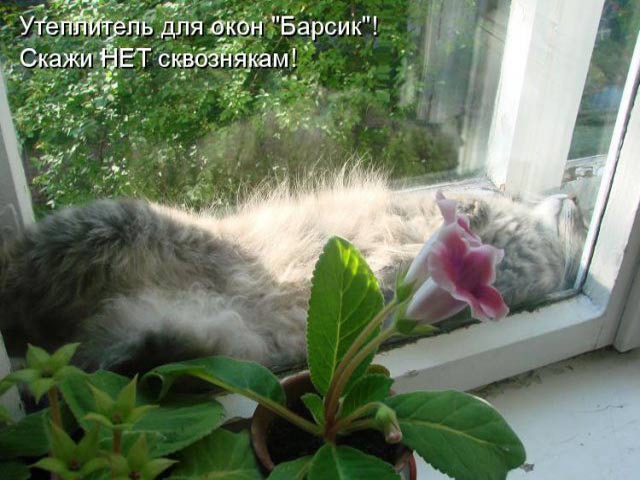
Well, perhaps, everything I wanted - said. If it was informative, then do not miss the exit new information. Are there friends who build a bath or house? Recommend the article to them.
Good luck and warm, well-cocked walls. Until!
Wisdom quote: So men are arranged: they can resist the most intelligent arguments and do not resist the only look (Bazzak).




